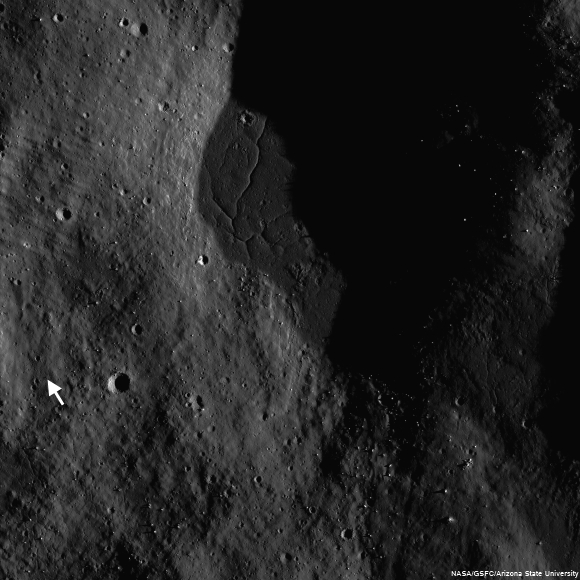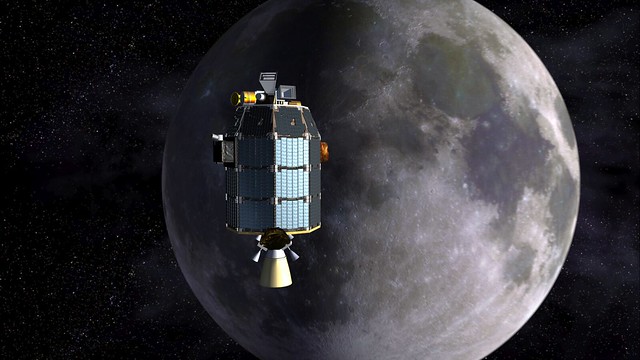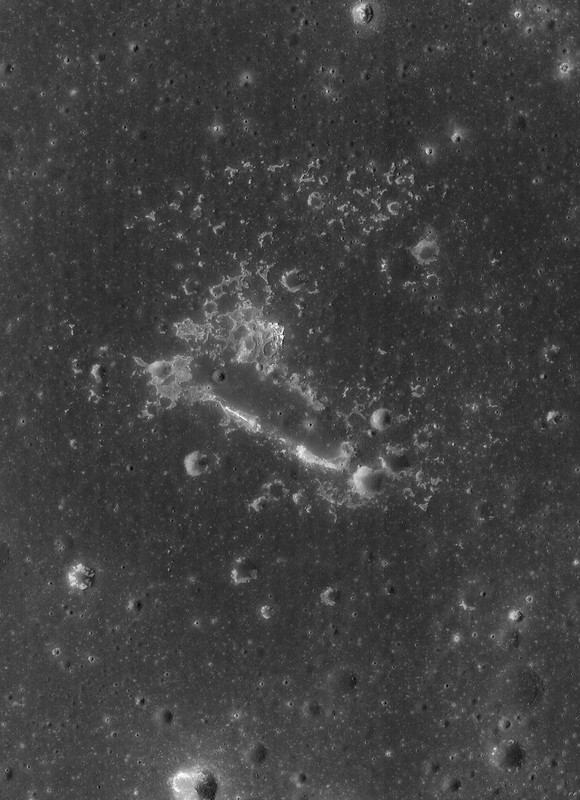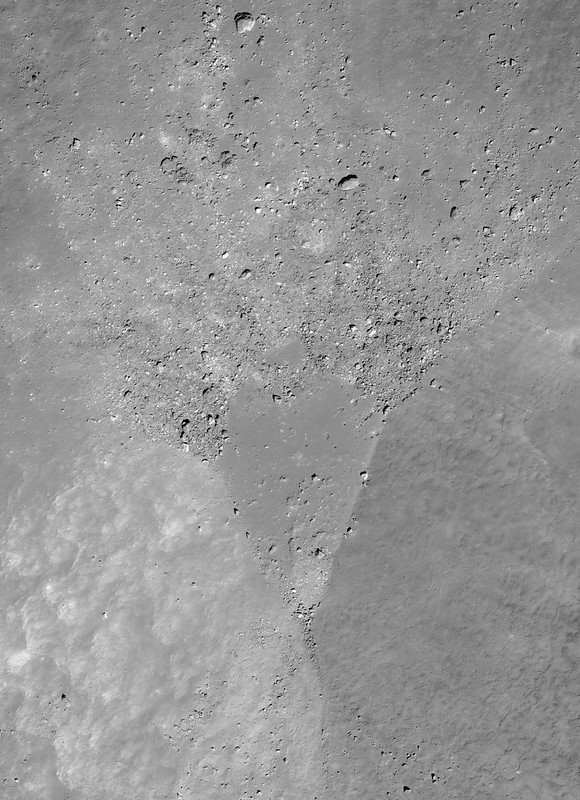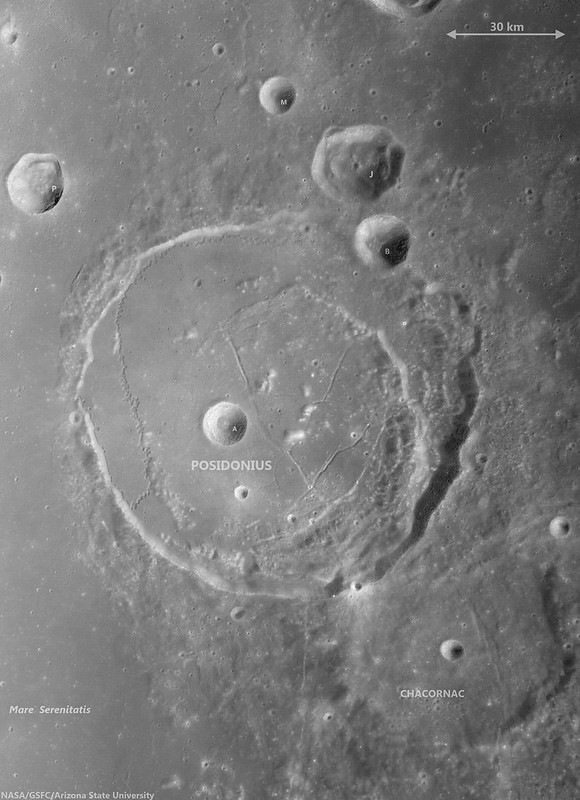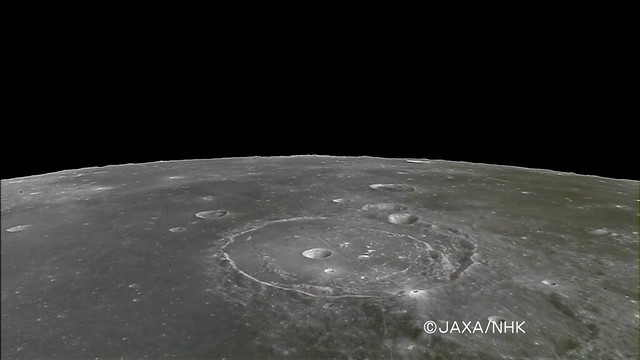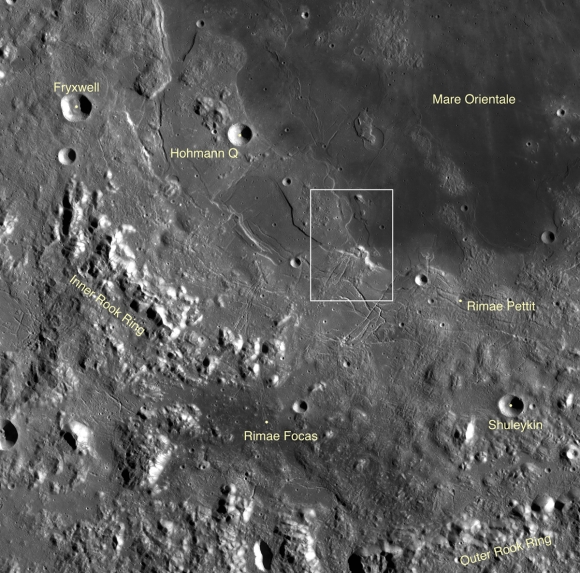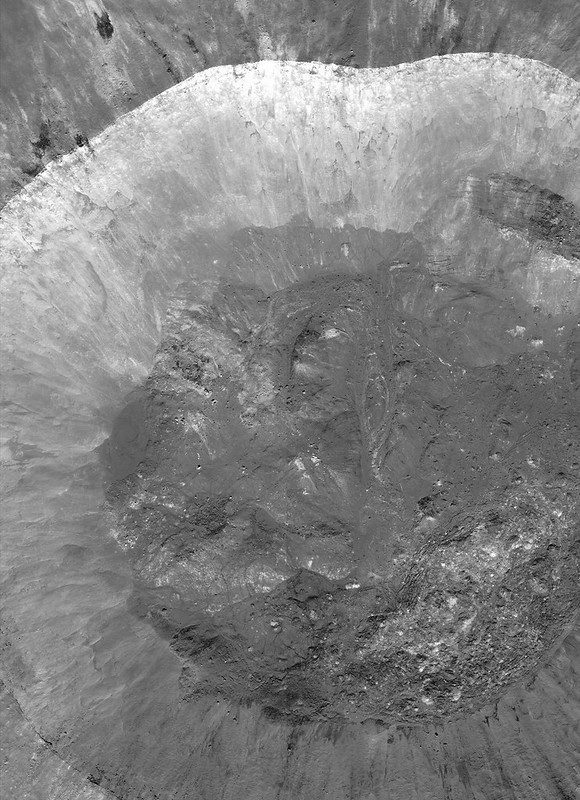 |
| The fresh lunar crater Giordano Bruno -a wealth of fascinating landforms to study. (click image for full resolution view, or HERE for a wider, medium resolution field of view showing the entire crater) [NASA/GSFC/Arizona State University]. |
The Once and Future Moon
Smithsonian Air & Space
Prior to the Space Age, one of the longest running controversies in lunar science was over the origin of the Moon’s craters. Two camps emerged, one favoring an internal (volcanic) origin and the other an external (impact by solid bodies) origin. Although this debate was finally resolved in favor of impact, the argument was long and vehement, reigniting at one point during the flight of the last of the robotic precursor probes to the Moon, prior to the Apollo landings. Although the basic physics of impact were well understood by the mid-1960s, this newest argument centered around high-resolution pictures obtained by Lunar Orbiter 5 (1967) of the fresh (and therefore young) crater Tycho. These spectacular images showed a multitude of flows, smooth ponds, and fluid rock, seemingly draped over hills and hummocks (like a chocolate shell coating over a scoop of ice cream).
An asteroid possesses an enormous amount of kinetic energy when it strikes a planetary body at very high speeds. On contact, the asteroid vaporizes and the surface target rocks are intensely compressed. After the shock wave has passed, these rocks decompress and the release of this energy totally melts part of the crustal target. This material is said to be shock melted, with the resulting liquid called impact melt. Impact melt was first described from craters on the Earth, particularly some of the very large impact craters found on the ancient Canadian Shield. These rocks superficially resemble some volcanic rocks, having both fine-grained textures and partly melted inclusions. But unlike volcanic rocks, they have high concentrations of siderophile (“iron-loving”) elements, such as iridium. These elements are extremely rare in the Earth’s crust, but are more abundant in meteorites and asteroids. It is thought that they are added to the melt from the incoming projectile.
The newest chapter in the argument about the origin of craters came about because some landforms around Tycho look similar to small-scale volcanic features on Earth. The idea proposed was that the craters had been formed by impact, with those collisions triggering volcanic activity and producing multiple episodes of eruption at Tycho and other craters. At first glance, such a scenario seems plausible. After all, impact is a catastrophic event and one can imagine churning seas of subsurface liquid rock, released suddenly through the creation of fractures deep in the crust. But the Moon’s interior is relatively cool. If interior melt exists, it is at a level much too deep for any reasonably sized impact to tap. But these amazing landforms needed to be explained. What might they represent?
We found abundant physical and chemical evidence for impact (including shock-melted rocks) by studying the Apollo samples. They appear similar to volcanic lava, with inclusions, melt textures and even vesicles (holes), comparable to the ones produced by magmatic volatiles coming out of solution in basaltic lavas on Earth. Although it took a bit of study (and many more arguments) to establish their origin, shock melting became recognized as an important lunar (and Earth) impact process.
An asteroid possesses an enormous amount of kinetic energy when it strikes a planetary body at very high speeds. On contact, the asteroid vaporizes and the surface target rocks are intensely compressed. After the shock wave has passed, these rocks decompress and the release of this energy totally melts part of the crustal target. This material is said to be shock melted, with the resulting liquid called impact melt. Impact melt was first described from craters on the Earth, particularly some of the very large impact craters found on the ancient Canadian Shield. These rocks superficially resemble some volcanic rocks, having both fine-grained textures and partly melted inclusions. But unlike volcanic rocks, they have high concentrations of siderophile (“iron-loving”) elements, such as iridium. These elements are extremely rare in the Earth’s crust, but are more abundant in meteorites and asteroids. It is thought that they are added to the melt from the incoming projectile.
The newest chapter in the argument about the origin of craters came about because some landforms around Tycho look similar to small-scale volcanic features on Earth. The idea proposed was that the craters had been formed by impact, with those collisions triggering volcanic activity and producing multiple episodes of eruption at Tycho and other craters. At first glance, such a scenario seems plausible. After all, impact is a catastrophic event and one can imagine churning seas of subsurface liquid rock, released suddenly through the creation of fractures deep in the crust. But the Moon’s interior is relatively cool. If interior melt exists, it is at a level much too deep for any reasonably sized impact to tap. But these amazing landforms needed to be explained. What might they represent?
We found abundant physical and chemical evidence for impact (including shock-melted rocks) by studying the Apollo samples. They appear similar to volcanic lava, with inclusions, melt textures and even vesicles (holes), comparable to the ones produced by magmatic volatiles coming out of solution in basaltic lavas on Earth. Although it took a bit of study (and many more arguments) to establish their origin, shock melting became recognized as an important lunar (and Earth) impact process.
 |
| Breech in the northwest rim of Tycho connects to the spectacular melt ponds inside out outside of the 109 million year old landmark crater. Illustration originally from "Landing Site at Tycho North," March 20, 2013 [NASA/GSFC/Arizona State University]. |
The images of the flows and ponds seen around Tycho and other fresh lunar craters led to a better understanding of how these rocks formed. Although we knew about impact melting from the study of Earth’s craters (and had found evidence of the same in lunar samples), some researchers still weren’t convinced that we were seeing flows of liquid impact melt on the Moon. The leading non-volcanic alternative was that these features were flows of dry, fine-grained granular debris. In part, this interpretation proceeded from the observation that the thermal signatures of some of these melt-like flows suggested the presence of fine debris rather than bare, jagged rock. Yet other data, such as radar backscatter, suggested that rough surfaces were common, while extremely high-resolution images showed abundant blocky craters on the surfaces of the flows, suggesting they were composed of solidified rock.
Surveyor 7 (1968) spacecraft, which landed on the rim of Tycho, revealed the thinnest regolith (soil) covering of any site on the Moon. Visible in the surface panoramas were flow features covering the distant hills. It took a great deal of painstaking, detailed work to establish that these flows and ponds were composed of liquid rock, created simultaneously with their host crater and likely originated by impact melting and subsequent solidification.
For the last several years, NASA’s Lunar Reconnaissance Orbiter (LRO) has been sending us new and astonishing views of the Moon’s impact melt flows. Whereas fresh craters like Tycho, Aristarchus and Copernicus were well known from previous Lunar Orbiter frames, far side craters like the spectacular Giordano Bruno can now be seen with incredible clarity. G. Bruno is one of the very youngest craters on the Moon. A low density of craters overlying G. Bruno suggests an age of less than a couple million years (extremely young on a planet where most features count years in the billions). It is an astonishing spectacle of melt shapes and deposits (cracked floors, pools, flow festoons and lobes); the crater floor has an amazing whirlpool of solidified melt. All these features indicate that after the crater formed, the impact melt was mobile, flowing and collecting, and ponding in low areas.
 |
| Impact melt forms a swirled feature in Giordano Bruno crater. Field of view 1 kilometer. From LROC Narrow Angle Camera (NAC) observation M143947267L LRO orbit 6347, November 9, 2010; 53.08° angle of incidence, 57 centimeters per pixel resolution from 54.50 km. Illustration from "Giordano Bruno Whorl," June 8, 2013 [NASA/GSFC/Arizona State University]. |
Increased understanding of the generation and deposition of impact melt comes from the new images obtained by the LRO camera of the geologic setting of impact melts. Future sample return missions to the Moon can be directed to landing sites that will provide us with samples of clear geological context (that they were from that area and not just flung there by an impact occurring elsewhere on the lunar surface). As features age on the Moon, subsequent geologic events (such as superposition of new units) bury or erase the original event making the context less clear. This problem is particularly acute for the oldest features on the Moon (multi-ring impact basins). By studying the geology of the freshest lunar features (such as Tycho and other fresh craters), we understand how the older impact features looked immediately after their formation. Thus, they serve as a guide to the interpretation of the older features. On the Moon, as on the Earth, as Charles Lyell, the 19th century author of the classic Principles of Geology aptly put it: The present is the key to the past.
Collection of spectacular impact melt features from LRO:
Giordano Bruno high-resolution full view
G. Bruno sunset
G. Bruno flows
G. Bruno cracked melts
Tycho oblique
Tycho floor
Tycho river of rock
Originally published July 31, 2013 at his Smithsonian Air & Space blog The Once and Future Moon, Dr. Spudis is a senior staff scientist at the Lunar and Planetary Institute. The opinions expressed are those of the author but are better informed than average.

